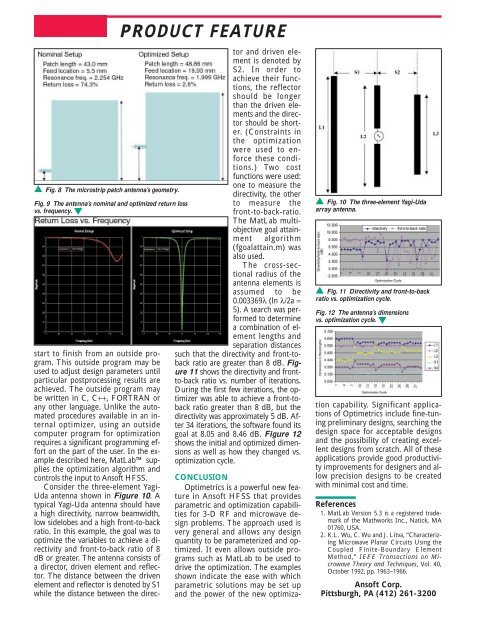Optimetrics: Parametrics and Optimization Using Ansoft HFSS
Optimetrics: Parametrics and Optimization Using Ansoft HFSS
Optimetrics: Parametrics and Optimization Using Ansoft HFSS
You also want an ePaper? Increase the reach of your titles
YUMPU automatically turns print PDFs into web optimized ePapers that Google loves.
▲ Fig. 8 The microstrip patch antenna’s geometry.<br />
Fig. 9 The antenna’s nominal <strong>and</strong> optimized return loss<br />
vs. frequency. ▼<br />
start to finish from an outside program.<br />
This outside program may be<br />
used to adjust design parameters until<br />
particular postprocessing results are<br />
achieved. The outside program may<br />
be written in C, C++, FORTRAN or<br />
any other language. Unlike the automated<br />
procedures available in an internal<br />
optimizer, using an outside<br />
computer program for optimization<br />
requires a significant programming effort<br />
on the part of the user. In the example<br />
described here, MatLab supplies<br />
the optimization algorithm <strong>and</strong><br />
controls the input to <strong>Ansoft</strong> <strong>HFSS</strong>.<br />
Consider the three-element Yagi-<br />
Uda antenna shown in Figure 10. A<br />
typical Yagi-Uda antenna should have<br />
a high directivity, narrow beamwidth,<br />
low sidelobes <strong>and</strong> a high front-to-back<br />
ratio. In this example, the goal was to<br />
optimize the variables to achieve a directivity<br />
<strong>and</strong> front-to-back ratio of 8<br />
dB or greater. The antenna consists of<br />
a director, driven element <strong>and</strong> reflector.<br />
The distance between the driven<br />
element <strong>and</strong> reflector is denoted by S1<br />
while the distance between the direc-<br />
PRODUCT FEATURE<br />
tor <strong>and</strong> driven element<br />
is denoted by<br />
S2. In order to<br />
achieve their functions,<br />
the reflector<br />
should be longer<br />
than the driven elements<br />
<strong>and</strong> the director<br />
should be shorter.<br />
(Constraints in<br />
the optimization<br />
were used to enforce<br />
these conditions.)<br />
Two cost<br />
functions were used:<br />
one to measure the<br />
directivity, the other<br />
to measure the<br />
front-to-back-ratio.<br />
The MatLab multiobjective<br />
goal attainment<br />
algorithm<br />
(fgoalattain.m) was<br />
also used.<br />
The cross-sectional<br />
radius of the<br />
antenna elements is<br />
assumed to be<br />
0.003369λ (ln λ/2a =<br />
5). A search was performed<br />
to determine<br />
a combination of element<br />
lengths <strong>and</strong><br />
separation distances<br />
such that the directivity <strong>and</strong> front-toback<br />
ratio are greater than 8 dB. Figure<br />
11 shows the directivity <strong>and</strong> frontto-back<br />
ratio vs. number of iterations.<br />
During the first few iterations, the optimizer<br />
was able to achieve a front-toback<br />
ratio greater than 8 dB, but the<br />
directivity was approximately 5 dB. After<br />
34 iterations, the software found its<br />
goal at 8.05 <strong>and</strong> 8.46 dB. Figure 12<br />
shows the initial <strong>and</strong> optimized dimensions<br />
as well as how they changed vs.<br />
optimization cycle.<br />
CONCLUSION<br />
<strong>Optimetrics</strong> is a powerful new feature<br />
in <strong>Ansoft</strong> <strong>HFSS</strong> that provides<br />
parametric <strong>and</strong> optimization capabilities<br />
for 3-D RF <strong>and</strong> microwave design<br />
problems. The approach used is<br />
very general <strong>and</strong> allows any design<br />
quantity to be parameterized <strong>and</strong> optimized.<br />
It even allows outside programs<br />
such as MatLab to be used to<br />
drive the optimization. The examples<br />
shown indicate the ease with which<br />
parametric solutions may be set up<br />
<strong>and</strong> the power of the new optimiza-<br />
▲ Fig. 10 The three-element Yagi-Uda<br />
array antenna.<br />
▲ Fig. 11 Directivity <strong>and</strong> front-to-back<br />
ratio vs. optimization cycle.<br />
Fig. 12 The antenna’s dimensions<br />
vs. optimization cycle. ▼<br />
tion capability. Significant applications<br />
of <strong>Optimetrics</strong> include fine-tuning<br />
preliminary designs, searching the<br />
design space for acceptable designs<br />
<strong>and</strong> the possibility of creating excellent<br />
designs from scratch. All of these<br />
applications provide good productivity<br />
improvements for designers <strong>and</strong> allow<br />
precision designs to be created<br />
with minimal cost <strong>and</strong> time.<br />
References<br />
1. MatLab Version 5.3 is a registered trademark<br />
of the Mathworks Inc., Natick, MA<br />
01760, USA.<br />
2. K.L. Wu, C. Wu <strong>and</strong> J. Litva, “Characterizing<br />
Microwave Planar Circuits <strong>Using</strong> the<br />
Coupled Finite-Boundary Element<br />
Method,” IEEE Transactions on Microwave<br />
Theory <strong>and</strong> Techniques, Vol. 40,<br />
October 1992, pp. 1963–1966.<br />
<strong>Ansoft</strong> Corp.<br />
Pittsburgh, PA (412) 261-3200

















